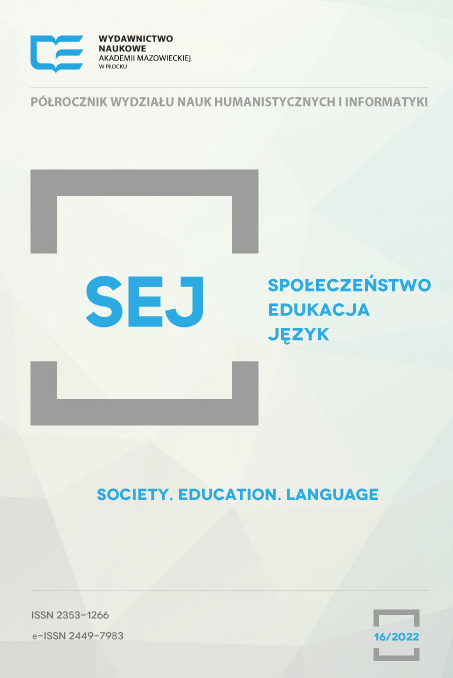THE PHATICITY OF THE INTERNET AUTOBIOGRAPHICAL PRACTICES
DOI:
https://doi.org/10.19251/sej/2022.16(15)Keywords:
phaticity, phatic function of language, phatic culture, autobiographical practices, InternetAbstract
The article concerns the growing importance of the phaticity in autobiographical practices conducted in the networked communication environment. The reason for undertaking research on this phenomenon is the recognition of the complexity of the evolution of autobiographical practices on the Internet and the need to understand the stages and directions of these changes. The aim of the presented article is to characterize the process of the intensification of the phaticity in the online autobiographical practices. This process will be explained on the basis of the genre characteristics of personal home pages, blogs, social networking sites and applications for transmitting ephemeral content. The methodological background of the analysis is built by concepts of the functions of language by Roman Jakobson and the phatic communion by Bronisław Malinowski, also by the theory of the phatic culture developed by Vincent Miller, connecting linguistic and cultural perspective. Results of the analysis conducted in the field of the Internet genology show that people conduct online autobiographical practices more often not to preserve their own experiences for themselves and for future generations, but to be in the constant contact with others.
References
Askehave, Inger i Nielsen, Anne Ellerup. 2005. Digital genres: a challenge to traditional genre theory. Information Technology & People, 2(18), 120−141. DOI: https://doi.org/10.1108/09593840510601504.
Bauman, Marcy Lassota. 1999. The evolution of internet genres. Computers and Composition, 2(16), 269−282. DOI: https://doi.org/10.1016/S8755-4615(99)00007-9.
Bralczyk, Jerzy. 1986. O rytuale propagandowym. Zeszyty Prasoznawcze, 2(108), 21−26.
Chandler, Daniel i Roberts-Young, Dilwyn. 1998. Personal home pages and the construction of identities on the Web. Dostęp: 10.05.2022. http://visual-memory.co.uk/daniel/Documents/short/webident.html.
Cheung, Chi-wai. 2000. A home on the web: Presentations of self in personal homepages. W: Web Studies: Rewiring Media Studies for the Digital Age, red. David Gauntlett, 43−51. London: Hodder Education Publishers.
Crowston, Kevin. 2018. Internet genres. W: Encyclopedia of Library and Information Science, red. John D. McDonald, Michael Levine-Clark, 2503−2515. Boca Raton: CRC Press.
Devitt, Amy J. 2009. Re-fusing form in genre study. W: Genres in the Internet, red. Janet Giltrow i Dieter Stein, 27−48. Amsterdam – Philadelphia: John Benjamins Pub. Co.
Doctorow, Cory et al. 2002. Essential Blogging: Selecting and Using Weblog Tools. Beijing et al.: O’Reilly.
Fedas, Anna. 2015. Internetowe gatunki dziennikarskie. Tradycyjne gatunki prasowe w cyfrowej formie, synkretyzm gatunkowy czy nowe wyzwania genologiczne? W: Gatunki mowy i ich ewolucja, red. Danuta Ostaszewska i Joanna Przyklenk, 412−418. Katowice: Wydawnictwo Uniwersytetu Śląskiego.
Giltrow, Janet i Stein, Dieter. 2009. Genres in the Internet: innovation, evolution, and genre theory. W: Genres in the Internet. Issues in the Theory of Genre, red. Janet Giltrow, Dieter Stein, 1−25. Amsterdam−Philadelphia: John Benjamins Pub. Co.
Grzenia, Jan. 2006. Komunikacja językowa w internecie. Warszawa: Wydawnictwo Naukowe PWN.
Hijmans, Ellen i van Selm, Martine. 2002. Between altruism and narcissism: an action theoretical approach of personal homepages devoted to existential meaning. Communication & Medicine, 1(27), 103−125. DOI: https://doi.org/10.1515/comm.27.1.103.
Jakobson, Roman. 1960. Poetyka w świetle językoznawstwa. Pamiętnik Literacki, 2(51), 431−473.
Kaczmarz, Ewa. 2018. Wzorzec gatunku internetowego. Prace Językoznawcze, 1(20), 71−81.
Kępa-Figura, Danuta. 2009. Gry językowe we współczesnej komunikacji medialnej: semantyczna i pragmatyczna analiza języka mediów. Prace Językoznawcze, 11, 95−113.
Kępa-Figura, Danuta. 2010. Istota fatyczności a komunikacja medialna. W: Teorie komunikacji i mediów 3, red. Marek Graszewicz i Jerzy Jastrzębski, 89−100. Wrocław: Oficyna Wydawnicza ATUT.
Lomborg, Stine. 2014. Social Media, Social Genres: Making Sense of the Ordinary. London−New York: Routledge.
Maciejewski, Marcin. 2009. Gatunki hipertekstu w perspektywie tekstologicznej. Analiza na przykładzie internetowej prezentacji przedsiębiorstw. Poznań: Wydawnictwo Naukowe UAM.
Malinowski, Bronisław. 1923. The problem of meaning in primitive languages. W: Ogden, Charles Kay i Richards, Ivor Armstrong. The Meaning of Meaning, 296−336. New York: Harcourt, Brace & World, Inc.
Maryl, Maciej. 2016. Tworzenie typologii gatunków piśmiennictwa multimedialnego na przykładzie blogów – propozycja metodologiczna. W: Metody badań online, red. Piotr Siuda. 360−398, Gdańsk: WN Katedra.
McNeill, Laurie. 2003. Teaching an old genre new trick: the diary on the Internet. Biography, 26(1), 24−47.
Miller, Nod i Morgan, David. 1993. Called to account: the CV as an autobiographical practice. Sociology, 1(27), 133−143.
Miller, Vincent. 2008. New media, networking and phatic culture. Convergence. The International Journal of Research into New Media Technologies, 4(14), 387−400. DOI: https://doi.org/10.1177/1354856508094659.
Miller, Vincent. 2017. Phatic culture and the status quo: reconsidering the purpose of social media activism. Convergence: The International Journal of Research into New Media Technologies, 3(23), 251−269. DOI: https://doi.org/10.1177/1354856515592512.
Naruszewicz-Duchlińska, Alina. 2011. Internetowe grupy dyskusyjne. Analiza językowa i charakterystyka gatunku. Olsztyn: Wydawnictwo Uniwersytetu Warmińsko-Mazurskiego.
O’Reilly, Tim. 2005. What is Web 2.0. Design patterns and business models for the next generation of software. Dostęp: 10.05.2022. https://www.oreilly.com/pub/a/web2/archive/what-is-web-20.html.
Rodríguez, Karlie. 2016. SnapCHAT: the genre of the vanishing memoir. Dostęp: 10.05.2022. http://isuwriting.com/wp-content/uploads/2016/07/Rodri%CC%81guez-Karlie-GWRJ7.1.pdf.
Sandberg, Marianne. 2003. Themes in Personal Homepages. A Systemic Functional Approach to Analyzing Texts in Personal Homepages by Ph.D. Students. Dostęp: 10.05.2022. https://extra.shu.ac.uk/daol/articles/closed/2003/005/sandberg2003005-paper.html.
Senft, Gunter. 2009. Phatic communion. W: Culture and Language Use, red. Gunter Senft, Jan-Ola Östman i Jef Verschueren, 228−233. Amsterdam−Philadelphia: John Benjamins Pub. Co.
Siles, Ignacio. 2011. The rise of blogging: articulation as a dynamic of technological stabilization. New Media & Society, 5(14), 781−797. DOI: https://doi.org/10.1177/1461444811425222.
Siwak, Wojciech. 2012. Autobiografizm w sieci – autobiografia jako baza danych. W: Autobiografizm w kulturze współczesnej, red. Katarzyna Citko i Marzanna Morozewicz, 135−159. Białystok: Trans Humana.
Tereszkiewicz, Anna. 2014. Charakterystyka gatunkowa i funkcjonalna wpisów medialnych na Twitterze. Poradnik Językowy, 8(717), 48−61.
Walker, Jill. 2005. Blog (Weblog). W: Routledge Encyclopedia of Narrative Theory, red. David Herman, Manfred Jahn i Marie-Laure Ryan, 45. Londyn−Nowy Jork: Routledge.
Wallace, Patricia. 1999. The Psychology of the Internet. Cambridge: Cambridge University Press.
Wynn, Eleanor i Katz, James E. 1997. Hyperbole over cyberspace: self-presentation and social boundaries in internet home pages and discourse. The Information Society, 4(13), 297−327.
